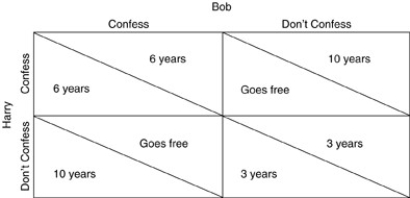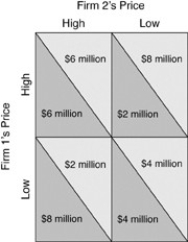A) positive market feedback.
B) non-dynamic market feedback.
C) negative market feedback.
D) elicit market feedback.
Correct Answer

verified
Correct Answer
verified
Multiple Choice
In a two-sided market with network effects, the platform will most likely
A) set the same prices for the two sides of the market.
B) set different prices for the two sides of the market.
C) set a price of zero for both sides of the market.
D) combine the two groups of the market before setting its price.
Correct Answer

verified
Correct Answer
verified
Multiple Choice
When there is a tendency for a particular product to come into favor with additional consumers because other consumers have chosen to purchase the product,
A) negative market feedback occurs.
B) positive market feedback occurs.
C) there is no dominant strategy.
D) a price war must result.
Correct Answer

verified
Correct Answer
verified
Multiple Choice
A market with many sellers, some influence over price, low barriers to entry, a differentiated product, and non-price competition often taking the form of advertising is known as
A) perfect competition.
B) monopolistic competition.
C) oligopoly.
D) monopoly.
Correct Answer

verified
Correct Answer
verified
Multiple Choice
A market situation in which there are a few large firms is called
A) monopolistic competition.
B) imperfect competition.
C) oligopoly.
D) monopoly.
Correct Answer

verified
Correct Answer
verified
Multiple Choice
When a new product is introduced in the market, Lenny always wants to see how popular the item becomes before he purchases it. Lenny's behavior is known as
A) overt collusion.
B) limit-pricing.
C) a network effect.
D) price leadership.
Correct Answer

verified
Correct Answer
verified
Multiple Choice
Which of the following is NOT a cause for an oligopoly to exist?
A) economies of scale
B) structural dependence
C) barriers to entry
D) horizontal mergers
Correct Answer

verified
Correct Answer
verified
Multiple Choice
A game in which all the players are better off at the end of the game is a
A) tit-for-tat game.
B) dominant strategy game.
C) positive-sum game.
D) noncooperative game.
Correct Answer

verified
Correct Answer
verified
Multiple Choice
There are fewer than half as many publishers of college textbooks in the United States now as a generation ago. Three companies alone account for almost two-thirds of the sale of new textbooks. This market situation characterized by very few sellers is known as
A) an oligopoly.
B) perfect competition.
C) pure monopoly.
D) monopolistic competition.
Correct Answer

verified
Correct Answer
verified
Multiple Choice
The joining of firms that are producing or selling a similar product is
A) competition by merger.
B) a vertical merger.
C) a horizontal merger.
D) a hostile takeover.
Correct Answer

verified
Correct Answer
verified
Multiple Choice
Economies of scale
A) do not arise in oligopolistic industries.
B) can exist but are rare in oligopolistic industries.
C) can exist but fail to create barriers to entry in oligopolistic industries.
D) are commonplace and often a barrier to entry in oligopolistic industries.
Correct Answer

verified
Correct Answer
verified
Multiple Choice
A game in which the players explicitly coordinate their decisions to make themselves better off is a
A) cooperative game.
B) noncooperative game.
C) zero-sum game.
D) negative-sum game.
Correct Answer

verified
Correct Answer
verified
Multiple Choice
 -Refer to the above figure. The figure gives the payoff matrix for two individuals who are being accused of robbing a bank together. Which of the following is the outcome with cooperation?
-Refer to the above figure. The figure gives the payoff matrix for two individuals who are being accused of robbing a bank together. Which of the following is the outcome with cooperation?
A) Both confess.
B) Both don't confess.
C) Bob confesses while Harry does not confess.
D) Harry confesses while Bo does not confess.
Correct Answer

verified
Correct Answer
verified
Multiple Choice
The payoff matrix shows all of the following EXCEPT 
A) if both oligopolists choose a high price, each makes $6 million.
B) if they both choose a low price, each makes $4 million.
C) if one chooses a low price and the other doesn't, the low priced firm will make $8 million.
D) if one oligopolist chooses a high price and the other doesn't, the high-priced firm makes $8 million.
Correct Answer

verified
Correct Answer
verified
Multiple Choice
An example of a positive market feedback is
A) the emergence of the iPod.
B) routine maintenance on a car.
C) the declining use of land-line telephones for long distance calls.
D) the use of telegraph services in the twenty-first century.
Correct Answer

verified
Correct Answer
verified
Multiple Choice
Oligopolistic industries are characterized by a
A) few large firms and no barriers to entry.
B) large number of firms and no barriers to entry.
C) few large firms and substantial barriers to entry.
D) large number of firms and substantial barriers to entry.
Correct Answer

verified
Correct Answer
verified
Multiple Choice
Economies of scale means that
A) the average fixed cost curve slopes downward over its entire range.
B) the four-firm concentration ratio is below 80.
C) the long-run average total cost curve slopes downward over it entire range.
D) the long-run total cost curve slopes downward over it entire range.
Correct Answer

verified
Correct Answer
verified
Multiple Choice
If a retail food chain merged with a meat packing company, this would be an example of a
A) horizontal merger.
B) conglomerate merger.
C) vertical merger.
D) diagonal merger.
Correct Answer

verified
Correct Answer
verified
Multiple Choice
In which market structures does a firm have at least some ability to set the market price?
A) Perfect competition and monopolistic competition.
B) Monopolistic competition and oligopoly.
C) Oligopoly and monopoly.
D) Monopolistic competition, oligopoly and monopoly.
Correct Answer

verified
Correct Answer
verified
Multiple Choice
Because all of his friends stopped exclusively wearing black clothes, Doug wears anything but black clothes. This is known as
A) a negative sum game.
B) collusion.
C) positive market feedback.
D) negative market feedback.
Correct Answer

verified
Correct Answer
verified
Showing 61 - 80 of 302
Related Exams